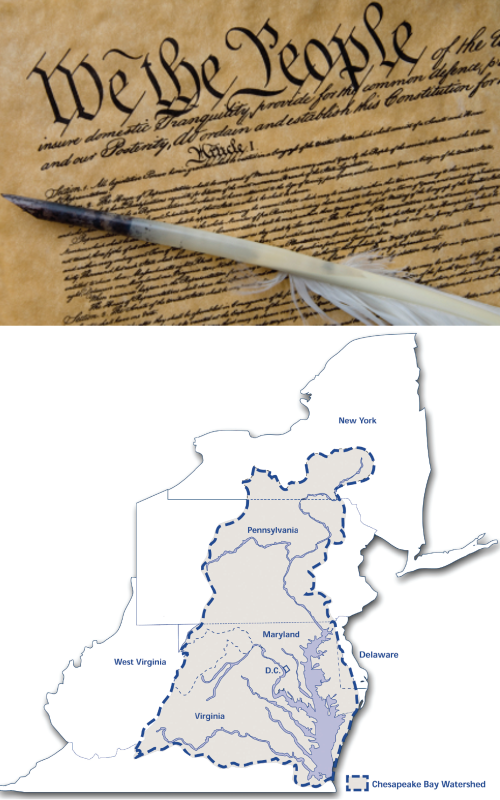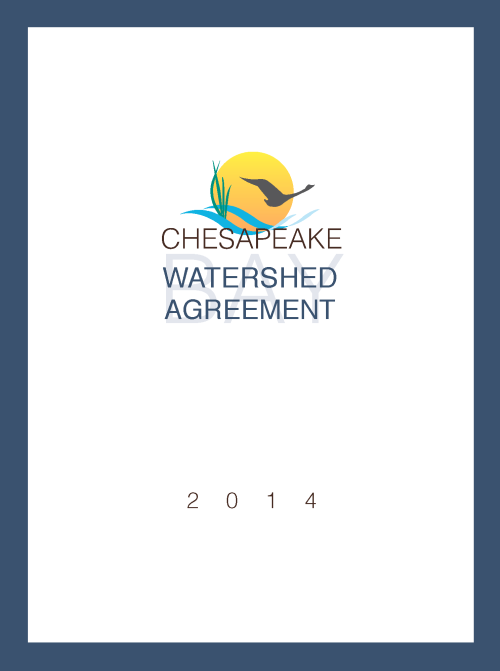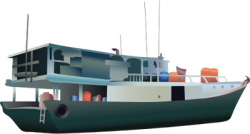Developing a constitution for Chesapeake Bay
Bill Dennison ·At a recent roundtable discussion of approaches for accelerating Chesapeake Bay restoration, one of the participants used the phrase "We the people..." which provoked me to think of the preamble to the United States Constitution, the beginning of an amazingly robust document that still resonates today. I hope that the 2014 Chesapeake Bay and Watershed Agreement will also have longevity and resonance, so I adapted the agreement into constitutional language as follows:
We the People of the Chesapeake Region, in Order to form a more perfect Bay, establish Protection, insure effective restoration, provide for the living resources, promote the water quality, and secure the Blessings of ecosystem resilience to ourselves and our Posterity, do ordain and establish this Constitution for the Chesapeake Bay watershed.

 Article 1. Protect, restore and enhance finfish, shellfish and other living resources, their habitats and ecological relationships to sustain all fisheries and provide for a balanced ecosystem in the watershed and Bay.
Article 1. Protect, restore and enhance finfish, shellfish and other living resources, their habitats and ecological relationships to sustain all fisheries and provide for a balanced ecosystem in the watershed and Bay.
Article 2. Restore, enhance and protect a network of land and water habitats to support fish and wildlife, and to afford other public benefits, including water quality, recreational uses and scenic value across the watershed.
 Article 3. Reduce pollutants to achieve the water quality necessary to support the aquatic living resources of the Bay and its tributaries and protect human health.
Article 3. Reduce pollutants to achieve the water quality necessary to support the aquatic living resources of the Bay and its tributaries and protect human health.
Article 4. Ensure that the Bay and its rivers are free of effects of toxic contaminants on living resources and human health.
Article 5. Sustain state-identified healthy waters and watersheds recognized for their high quality and/or high ecological value.
Article 6. Increase the number and the diversity of local citizen stewards and local governments that actively support and carry out the conservation and restoration activities that achieve healthy local streams, rivers and a vibrant Chesapeake Bay.
 Article 7. Conserve landscapes treasured by citizens in order to maintain water quality and habitat; sustain working forests, farms and maritime communities; and conserve lands of cultural, indigenous and community value.
Article 7. Conserve landscapes treasured by citizens in order to maintain water quality and habitat; sustain working forests, farms and maritime communities; and conserve lands of cultural, indigenous and community value.
Article 8. Expand public access to the Bay and its tributaries through existing and new local, state and federal parks, refuges, reserves, trails and partner sites.
Article 9. Enable every student in the region to graduate with the knowledge and skills to act responsibly to protect and restore their local watershed.
Article 10. Increase the resiliency of the Chesapeake Bay watershed, including its living resources, habitats, public infrastructure and communities, to withstand adverse impacts from changing environmental and climate conditions.

And since the U.S. Constitution would not be complete without the first ten amendments known as the Bill of Rights, here is the Chesapeake Bay version of the Bill of Rights:
 I.) The Government shall make no law respecting the establishment of aquaculture, or prohibiting the free exercise thereof; or abridging the freedom of skipjacks, or of the Bugeye; or the right of the fish peaceably to assemble, and to petition the Government for a redress of overfishing grievances.
I.) The Government shall make no law respecting the establishment of aquaculture, or prohibiting the free exercise thereof; or abridging the freedom of skipjacks, or of the Bugeye; or the right of the fish peaceably to assemble, and to petition the Government for a redress of overfishing grievances.
II.) A well-regulated Natural Resources Police, being necessary to the security of a healthy Bay, the right of the people to keep and bear Tongs, shall not be infringed.
 III.) No Waterman shall, in time of peace be quartered in any house, without the consent of the Owner, nor in time of oyster wars, but in a manner to be prescribed by law.
III.) No Waterman shall, in time of peace be quartered in any house, without the consent of the Owner, nor in time of oyster wars, but in a manner to be prescribed by law.
IV.) The right of the oysters to be secure in their shells, bars, sanctuaries, and living shorelines, against unreasonable searches and seizures, shall not be violated, and no Fishing license shall issue, but upon probable cause, supported by Oath or affirmation, and particularly describing the place to be fished, and the oysters or clams to be seized.
V.) No crabber shall be held to answer for poaching, or otherwise infamous crime, unless on a presentment or indictment of a Grand Jury, except in cases arising in the winter dredge survey, or in the disease testing, when in actual service of science; nor shall any person be subject for the same offense to be twice put in jeopardy of life or limb; nor shall be compelled in any criminal case to be a witness against himself, nor be deprived of life, liberty, or  property, without due process of law; nor shall crab pots be taken for public use, without just compensation.
property, without due process of law; nor shall crab pots be taken for public use, without just compensation.
VI.) In all criminal runoff, stormwater shall enjoy the right to a speedy and public treatment, by an impartial best management practice, wherein the runoff shall have been committed, which watershed shall have been previously impaired, and to be treated as to the nature and cause of the pollution; to be confronted with the evidence against it; to have compulsory process for obtaining treatment in its favor, and to have the Assistance of Government for its treatment.
VII.) In TMDL1 at common law, where the value in controversy affects the Bay, the right of trial by jury shall be preserved, and no fact tried by a jury, shall be otherwise re-examined in any Court of the United States, than according to the rules of the common law.
VIII.) Excessive fishing shall not be permitted, nor excessive runoff imposed, nor cruel and  unusual punishments inflicted upon the Bay.
unusual punishments inflicted upon the Bay.
IX.) The enumeration in the Chesapeake Bay Agreement, of certain restoration actions, shall not be construed to deny or disparage other restoration actions initiated by the people.
X.) The powers not delegated to the United States EPA2 by the Agreement, nor prohibited by it to the States, are reserved to the States respectively, or to the people.
1TMDL = Total Maximum Daily Load, the regulatory framework for Chesapeake Bay, as known as the "Pollution Diet"
2EPA = Environmental Protection Agency, the lead federal government agency for the partnership known as the Chesapeake Bay Program.
3All symbols from the IAN Symbols Library
About the author
Bill Dennison

Dr. Bill Dennison is a Professor of Marine Science and Vice President for Science Application at the University of Maryland Center for Environmental Science.

